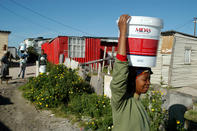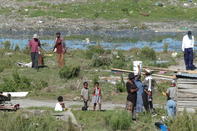The Problem of an RDP House
A report by the Development Bank of South Africa (DBSA) showed that families who can afford to live in bricks-and-mortar houses are better off in terms of both being more food secure and having safe food, because they tend to be wealthier and live in properly serviced homes. However, the same does not necessarily apply to people living in subsidised RDP-type housing developments.

In fact, new research by Stellenbosch University’s Division of Community Health suggests that those living in RDP homes might be worse off than people living in shacks in terms of their possible exposure to infections related to poor sanitation.
With the massive backlog in formal housing in South African cities, the state’s subsidised housing scheme is a way of getting the poorest families out of badly serviced shanty communities and into formal structures.
The central government partly funds the development, the local municipality has to build the houses and maintain infrastructure and the utilities in the community, and the individual families have to maintain their own homes.
But the problem is that most of the families who qualify for subsidised housing are among the country’s poorest, meaning that once they move into the home, they do not necessarily have the money or skills for routine maintenance or even to buy cleaning products.
And because of shoddy workmanship or low-budget construction, so many of these housing schemes fall into disrepair not long after they are occupied – and the new owners generally do not have the cash to pay for repairs.
One Water Point for Many People
One way for an indigent homeowner to substitute an income is to build one or two little shanties in the backyard and rent them out to another family.
Before long, there might be as many as 20 people living on one tiny property, both in the house and in the shacks in the backyard. (Surprisingly, many backyard shanty dwellers turn out to be wealthier and more employed than their landlords since they can afford to pay rent on a shack, while their landlords benefit from living in a home that they got free from the state.) But since many of the RDP homes come with the most basic specifications – one tap, one basin, one toilet – it effectively means these function like a public ablution facility, given the number of people using them.
It also puts the facilities under enormous pressure, speeding up their deterioration. When Dr Jo Barnes and Dr Thashlin Govender from the Division of Community Health, along with Groote Schuur Hospital’s Professor Clarissa Pieper, took a closer look at four established RDP communities around Cape Town (they focused on Driftsands, Greenfield, Masipumelela and Tafelsig), all of which had backyard dwellers, they found some of the conditions in these homes were far from ideal.
And, surprisingly, the result was that those living in the formal houses were getting diarrhoea significantly more often than the people living in the shacks in the backyard. Because each house might only have one water point and a single basin, these become the hub for just about any activity involving water.
Barnes says that in the homes they visited for this research, they would find a single basin would be used to clean food, do the dishes, wash laundry and bath the baby. And since the people living in these homes might not be fully aware of the risks, or might not be able to afford cleaning materials, many of the basins and sinks were blocked and very dirty.
‘And then you have many water re-use proponents telling people to grow their own vegetables in their gardens by using grey water from the kitchen. This tightens the cycle of contamination because any pathogens in the kitchen are being put onto the veggies, and then the veggies bring these back into the kitchen when they are harvested. So you may just be spinning the wheel of infection risk even faster.’
Proximity to Contaminated Water

More than half of the toilets in the homes they visited were blocked, broken or leaking. Most homes did not have toilet paper, leaving people to resort to using newspaper. Few of the bathrooms had soap so that people could wash their hands, and in some cases, there was not a tap near the toilet, so people could not wash their hands after using the loo.
When the toilets become blocked or do not flush properly, people use potties which they empty out into storm water drains or sometimes directly onto the street. Since so many children play out in the streets, and people walk through this kind of raw sewerage daily, the risk of contamination is high.
Then, when the first seasonal rains come, there tends to be a spike in the incidence of diarrhoea because there might be just enough water to stir up the contaminants and leave it in stagnant puddles and pools, but not enough to flush it away down the stormwater drains. But why were the people in the formal structures getting more diarrhoea than the people in the unserviced shacks at the back?
Barnes and colleagues’ survey found that 40% of the RDP homes reported cases of diarrhoea in the two weeks leading up to their visit, while only 23% of the shack-dwelling homes had had bouts of diarrhoea during the same time. Simple, explains Barnes: the people living in the RDP houses are living and sleeping much closer to the blocked and broken drains and leaking toilets than the shack dwellers are.
‘Their proximity to the source of blocked and broken drains and toilets inside the house keeps driving this continual background infection.
The closer you are to the source, the quicker you will get ill.’ What was quite alarming, in the context of the issues reported on in this chapter, is that during their research, a number of the people surveyed were willing to give their HIV and TB status voluntarily – and yet none of these people were on medication for their illnesses. This just highlights, once more, how vulnerable communities living in these kinds of conditions really are.
RDP Failing to Improve Health
Water is a double-edged sword: it is nature’s best cleaning medium, so when it is used correctly, it is critical for our good health; but it is also one of the best mechanisms for spreading diarrhoeal-type disease. Get it right with water, and you are healthier, you will spend less on doctor or clinic visits, and you do not lose as many work or school days.
Get it wrong, and you are at risk of becoming another statistic. In middle-and-low-income countries, diarrhoeal disease claims nearly five lives out of every 1 000 children, who are under the age of five, and is the third most common cause of death in this age group. In South Africa, it accounts for just over 3% of all deaths, making it the ‘eighth most frequent cause of death in the country’, write Barnes and her colleagues.
Access to clean water and sanitation are absolutely essential for a community’s good health. And yet, if the purpose of the RDP and Breaking New Ground initiative is to improve people’s health through giving them formal houses with water and sanitation, this research shows that it is failing in its primary goal. People living in shacks, further from the failing ablution facilities, are actually healthier than those living in the formal houses.
By Leonie Joubert